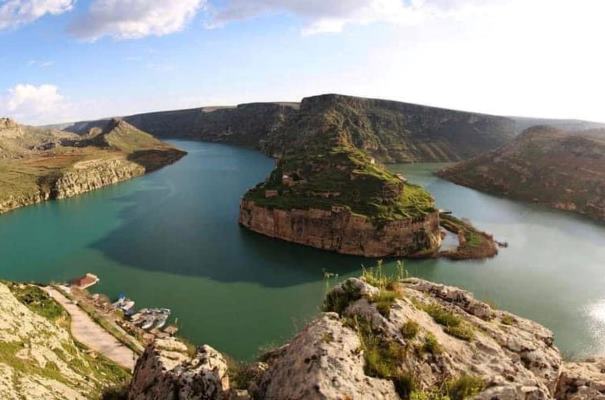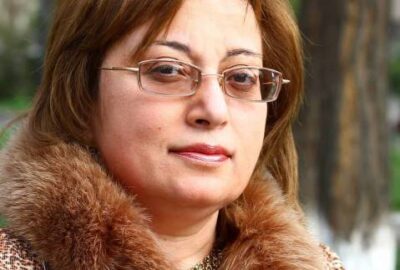Կիլիկյան Հայաստանի նշանավոր Հռոմկլա բերդաքաղաքը

(Please scroll down for English text)
Բերդաքաղաքը գտնվում էր Եփրատ գետի աջ ափին` Փարզման վտակի միախառնման տեղում, սեպաձև հրվանդանի վրա, շրջափակված դժվարամատչելի ժայռերով:
Ամրոցը 1149-1292 թվականներին ծառայել է որպես Ամենայն Հայոց Կաթողիկոսի նստավայրը։
Միջնադարյան Հռոմկլայում են գործել ամենայն
հայոց կաթողիկոսներ՝
Սուրբ Ներսես Շնորհալին (Ներսես Դ Կլայեցի) (1166-1173),Գրիգոր Դ Տղան («Տղա» մականունն ստացել է իբրև կաթողիկոսի որդեգիր, կաթողիկոսարանում մեծանալու և ապրելու պատճառով) (1173-1193),
Կոստանդին Ա Բարձրբերդցին (1221-1267) Կաթողիկոս Ներսես Շնորհալու օրոք (1166-1173) Հռոմկլան դարձել է համահայկական մշակութային կենտրոն և հռչակվել է իր ուրույն ու բարձրարվեստ մանրանկարչական դպրոցով։
Այս դպրոցի առաջին վարպետը եղել է Կիրակոսը։ Կիրակոսի հետ 1260-ական թվականների մանրանկարչության մեկ այլ վարպետ էր Հովհհաննեսը և ուրիշներ:
Հայ կիլիկյան դպրոցի մանրանկարիչ և գրիչ Թորոս Ռոսլին նույնպես ստեղծագործել է Հռոմկլայում, ով արվեստագետների կողմից անվանվել է «Վերածնության նախակարապետ», «Զարդանկարի վիրտուոզ»։
Հռոմկլան իր ծաղկման բարձրակետին է հասել Կոստանդին Ա Բարձրբերդցի կաթողիկոսի (1221–1267) օրոք:
Մինչև 1292-ը Հռոմկլայում է եղել Հայոց կաթողիկոսական աթոռը, ապա 1375 թվականին կործանվել է Կիլիկյան թագավորությանը:
Հղման մեջ ընդգրկված են՝![]() «Բարսեղ Պահլավունու խաչքարը»
«Բարսեղ Պահլավունու խաչքարը»
Այս եզակի խաչքարը՝ հայտնաբերվել է Կիլիկյան Հայաստանի Հռոմկլա բերդաքաղաքից, 1150թ.
Կիլիկիո Ն.Ս.Օ.Տ.Տ., Անթիլիաս, Լիբանան![]() 13-րդ դարի Բարձրաբերդի ավետարանական գրքի կազմը
13-րդ դարի Բարձրաբերդի ավետարանական գրքի կազմը
Այս ձեռագիր ավետարանը գրվել է 1248 թվականին, մանրանկարիչն էր Կիրակոսը, ով եղել է Թորոս Ռոսլինի (13-րդ դարի Կիլիկիայի նշանավոր մանրանկարիչներից) ուսուցիչը։ Բարձրբերդի Ավետարանական գրքի ոսկզօծ, կաշվե կազմը՝ զարդարված թանկարժեք քարերով, պատրաստվել է 1254թ.-ին՝ նույպես Հռոմկլա բերդում՝ Վարդանի կողմից:
Ավետարանը պահպանվում է Մեծի Տանն Կիլիկիո կաթողիկոսարանում, Անթիլիաս, Լիբանան:
Լուսանկարները ՝ Կիլիկիայի Սուրբ Աթոռի:![]() 1262 թվականի Կիլիկիայի Հռոմկլա բերդաքաղաքում Թորոս Ռոսլինի ծաղկած ձեռագրերից մեկը, որը պահվում է Ուոլտերսի արվեստի թանգարանում:
1262 թվականի Կիլիկիայի Հռոմկլա բերդաքաղաքում Թորոս Ռոսլինի ծաղկած ձեռագրերից մեկը, որը պահվում է Ուոլտերսի արվեստի թանգարանում:![]() The Famous Hromkla fortress of Cilician Armenia
The Famous Hromkla fortress of Cilician Armenia
The city-fortress was located on the right bank of the Euphrates River, at the confluence of the Parzman tributary, on a wedge-shaped cape surrounded by impregnable cliffs.
The fortress served as the residence of the Catholicos of All Armenians from 1149 till 1292:
The Catholicos St. Nerses Shnorhali (Nerses D. Klayetsi) was a Catholicos of Armenia from 1166 to 1173.
The Catholicos Gregory IV the Son (1173-1193): He grew up and lived in the Catholicosate and received the nickname “Boy” as an adopted son of the Catholicos.
The Catholicos Constantine I of Bardzrberd: Catholicos Constantine I was the Catholicos of the Armenian Apostolic Church between 1221 and 1267.
The beginning of the development of writing houses in Hromkla dates to the 1160s century. The oldest illustrated manuscript from Hromkla is a 1166 Gospel. The city of Hromkla became the center of the development of the Cilician school of miniature in the second half of the 13th century.
This development was closely related to the activities of Catholicos Constantine I Bardzraberdtsi. The first master of this school was Kirakos. Along with Kirakos, another master of miniature of the 1260s was Hovhannes.
The prominent manuscript illuminator, miniature painter of the Armenian school of Cilicia worked at the scriptorium of Hromkla and called by artists “Renaissance forerunner”, “Ornamental virtuoso”.
A significant number of manuscripts by unknown artists of the second half of the century have been preserved. However, after the fall of Hromkla (where the throne of the Catholicos was located) in 1292, the Cilician miniature school suffered a decline, with thematic miniatures being no longer created.
The famous artists working at the scriptorium at Hromkla, the patriarchate, or headquarters, of the Armenian Church—created elegant images reflecting the cross-cultural ties of Cilicia that had a lasting impact on Armenian art.
This post includes:![]() “Khachkar of Basil Pahlavuni”
“Khachkar of Basil Pahlavuni”
This unique khachkar found in Hromkla fortress of Cilician Armenia, 1150
Holy See of Cilicia, Antelias, Lebanon
https://www.metmuseum.org/art/collection/search/688273![]() The Bardzrberd Gospel Book cover, 13th century
The Bardzrberd Gospel Book cover, 13th century
The Bardzrberd Gospel Book was written in 1248 and it’s gilded-silver leather cover, decorated with gemstones. It was made in 1254 by Vartan in Hromkla Fortress.
Its miniature painter is Kirakos, who was the teacher of Toros Roslin (One of the famous miniature painter in Cilicia, during 13th century).
The Gospel Book is preserved in the Holy See of Cicilia, Antelias, Lebanon
Photograph courtesy of Holy See of Cilicia.![]() This particular manuscript was created at the scriptorium of Hromkla. The manuscript was made in 1262 by T’oros Roslin, an extremely prominent illuminator, who extended the range of manuscript illuminations by introducing a whole cycle of images into the gospels.
This particular manuscript was created at the scriptorium of Hromkla. The manuscript was made in 1262 by T’oros Roslin, an extremely prominent illuminator, who extended the range of manuscript illuminations by introducing a whole cycle of images into the gospels.
«Armenia — An Ancient Land» ֆեյսբուքյան խմբից
Գրառող՝ Անահիտ Հայրապետյան





